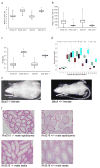Disease model discovery from 3,328 gene knockouts by The International Mouse Phenotyping Consortium
- PMID: 28650483
- PMCID: PMC5546242
- DOI: 10.1038/ng.3901
Disease model discovery from 3,328 gene knockouts by The International Mouse Phenotyping Consortium
Abstract
Although next-generation sequencing has revolutionized the ability to associate variants with human diseases, diagnostic rates and development of new therapies are still limited by a lack of knowledge of the functions and pathobiological mechanisms of most genes. To address this challenge, the International Mouse Phenotyping Consortium is creating a genome- and phenome-wide catalog of gene function by characterizing new knockout-mouse strains across diverse biological systems through a broad set of standardized phenotyping tests. All mice will be readily available to the biomedical community. Analyzing the first 3,328 genes identified models for 360 diseases, including the first models, to our knowledge, for type C Bernard-Soulier, Bardet-Biedl-5 and Gordon Holmes syndromes. 90% of our phenotype annotations were novel, providing functional evidence for 1,092 genes and candidates in genetically uncharacterized diseases including arrhythmogenic right ventricular dysplasia 3. Finally, we describe our role in variant functional validation with The 100,000 Genomes Project and others.
Conflict of interest statement
The authors declare no competing financial interests
Figures




References
MeSH terms
Grants and funding
- UM1 OD023222/OD/NIH HHS/United States
- U54 HG006332/HG/NHGRI NIH HHS/United States
- P30 CA034196/CA/NCI NIH HHS/United States
- UM1 OD023221/OD/NIH HHS/United States
- R24 OD011883/OD/NIH HHS/United States
- U42 OD012210/OD/NIH HHS/United States
- MC_U142684172/MRC_/Medical Research Council/United Kingdom
- UM1 HG006370/HG/NHGRI NIH HHS/United States
- U54 HG006348/HG/NHGRI NIH HHS/United States
- U54 HG006370/HG/NHGRI NIH HHS/United States
- U42 OD011185/OD/NIH HHS/United States
- U54 HG006364/HG/NHGRI NIH HHS/United States
- UM1 HG006348/HG/NHGRI NIH HHS/United States
- U42 OD011174/OD/NIH HHS/United States
- U42 OD011175/OD/NIH HHS/United States
- WT_/Wellcome Trust/United Kingdom
- MC_UP_1502/3/MRC_/Medical Research Council/United Kingdom
- MC_U142684171/MRC_/Medical Research Council/United Kingdom
LinkOut - more resources
Full Text Sources
Other Literature Sources
Molecular Biology Databases

